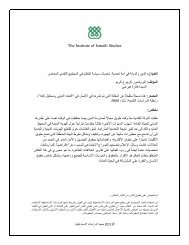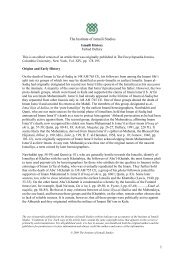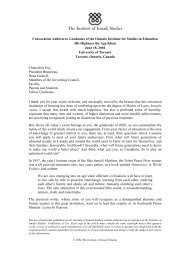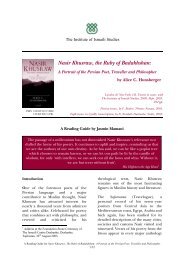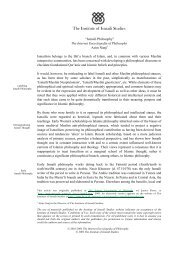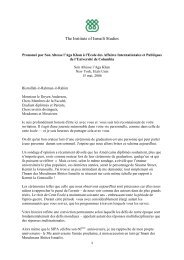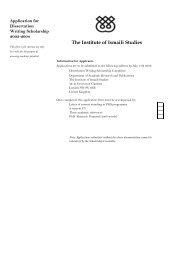Intellectual life in Fatimid Times - The Institute of Ismaili Studies
Intellectual life in Fatimid Times - The Institute of Ismaili Studies
Intellectual life in Fatimid Times - The Institute of Ismaili Studies
You also want an ePaper? Increase the reach of your titles
YUMPU automatically turns print PDFs into web optimized ePapers that Google loves.
<strong>The</strong> <strong>Institute</strong> <strong>of</strong> <strong>Ismaili</strong> <strong>Studies</strong><br />
<strong>Intellectual</strong> <strong>life</strong> <strong>in</strong> <strong>Fatimid</strong> <strong>Times</strong><br />
A Read<strong>in</strong>g Guide<br />
<strong>The</strong> <strong>Fatimid</strong>s and <strong>The</strong>ir Traditions <strong>of</strong> Learn<strong>in</strong>g<br />
by He<strong>in</strong>z Halm (I.B. Tauris, London and New York, <strong>in</strong> association with <strong>The</strong> <strong>Institute</strong> <strong>of</strong><br />
<strong>Ismaili</strong> <strong>Studies</strong>, London, 1997. xiii + 100 pp. ISBN 1-86064-434-1)<br />
In less than a hundred pages He<strong>in</strong>z Halm looks at the <strong>Fatimid</strong> caliphate from an angle that allows<br />
readers to appreciate, more than ever before, the <strong>in</strong>tellectual traditions prevalent and encouraged<br />
dur<strong>in</strong>g the <strong>Fatimid</strong> epoch. He <strong>of</strong>fers a panoramic perspective on the work<strong>in</strong>g <strong>of</strong> the da‘wa, the<br />
promotion <strong>of</strong> learn<strong>in</strong>g through the establishment <strong>of</strong> the al-Azhar and the Dar al-‘Ilm (House <strong>of</strong><br />
Knowledge), and the majalis al-hikma (sessions <strong>of</strong> wisdom) held for <strong>in</strong>struction <strong>in</strong> <strong>Ismaili</strong><br />
doctr<strong>in</strong>es. He discusses <strong>in</strong>tellectual endeavours <strong>of</strong> the <strong>Fatimid</strong>s both <strong>in</strong> the context <strong>of</strong> the sociopolitical<br />
conditions <strong>of</strong> the times as well as <strong>in</strong> the light <strong>of</strong> the Shi‘i emphasis on knowledge go<strong>in</strong>g<br />
back to the period <strong>of</strong> the early Imams.<br />
For those <strong>in</strong>terested <strong>in</strong> history, and especially the history <strong>of</strong> the <strong>Ismaili</strong>s, this book is highly<br />
recommended. <strong>The</strong> emphasis on teach<strong>in</strong>g and learn<strong>in</strong>g will appeal to teachers and educators,<br />
particularly those concerned with religious education and the history <strong>of</strong> education. With a jargonfree,<br />
lucid writ<strong>in</strong>g style, the book can make an educative read<strong>in</strong>g for any one with an <strong>in</strong>terest <strong>in</strong><br />
<strong>Ismaili</strong> thought and history.<br />
<strong>The</strong> Structure <strong>of</strong> the Book<br />
In the open<strong>in</strong>g chapter, <strong>The</strong> <strong>Ismaili</strong> Mission and the <strong>Fatimid</strong> Caliphate, Halm provides a concise<br />
outl<strong>in</strong>e <strong>of</strong> the <strong>Fatimid</strong> caliphate <strong>in</strong> order to equip the reader with a background <strong>in</strong> <strong>Fatimid</strong> history.<br />
He beg<strong>in</strong>s with a synopsis <strong>of</strong> the situation <strong>in</strong> Syria <strong>in</strong> the n<strong>in</strong>th century (where Imam al-Mahdi<br />
was stay<strong>in</strong>g) prior to the establishment <strong>of</strong> the <strong>Fatimid</strong> state <strong>in</strong> 909 CE. He then turns his attention to<br />
the Imam-Caliph al-Mahdi (d. 934 CE) and provides an <strong>in</strong>sight <strong>in</strong>to the circumstances that<br />
surrounded the establishment <strong>of</strong> the <strong>Fatimid</strong> state. <strong>The</strong> chapter provides an overview <strong>of</strong> the reign <strong>of</strong><br />
the next three Imams, end<strong>in</strong>g with a reference to the peaceful conquest <strong>of</strong> Egypt under the<br />
fourth Imam-Caliph al-Mu‘izz (d. 975 CE).<br />
<strong>The</strong> second chapter, <strong>The</strong> Mission <strong>of</strong> the da‘is and the ‘Teach<strong>in</strong>g Sessions’, elaborates on the<br />
activities <strong>of</strong> teach<strong>in</strong>g and learn<strong>in</strong>g carried out by the da‘is (summoners) with<strong>in</strong> the <strong>Fatimid</strong> state<br />
dur<strong>in</strong>g its North African phase. Of particular <strong>in</strong>terest is the discussion <strong>of</strong> the <strong>in</strong>itiation process<br />
used by the <strong>Ismaili</strong> da‘is to w<strong>in</strong> over people <strong>of</strong> different persuasions. Special attention is given to<br />
two important da‘is <strong>of</strong> the period, Abu ‘Abd Allah al-Shi‘i (d. 911 CE) and al-Qadi al-Nu‘man<br />
(d. 974 CE).<br />
<strong>The</strong> third chapter, <strong>The</strong> <strong>Fatimid</strong>s <strong>in</strong> Egypt, <strong>of</strong>fers a historical perspective on the acquisition <strong>of</strong><br />
Egypt by the <strong>Fatimid</strong> general Jawhar. Though most <strong>of</strong> the chapter focuses on the reign and<br />
<strong>Intellectual</strong> Life <strong>in</strong> <strong>Fatimid</strong> <strong>Times</strong> 1
accomplishments <strong>of</strong> the Imam al-Hakim (d. circa 1021 CE), the rule <strong>of</strong> the Imams al-Mu‘izz and al-<br />
‘Aziz (d. 996 CE) are also given fair consideration. In discuss<strong>in</strong>g the reign <strong>of</strong> Imam al-Hakim, the<br />
author attempts to dispel some unfavourable views about the Imam generally held by historians.<br />
<strong>The</strong> fourth chapter, <strong>Ismaili</strong> Teach<strong>in</strong>g and Learn<strong>in</strong>g: zahir and bat<strong>in</strong>, can be considered as the<br />
heart <strong>of</strong> the book. Here, the author explicates a cornerstone <strong>of</strong> the <strong>Fatimid</strong> <strong>Ismaili</strong> approach to<br />
religious knowledge and understand<strong>in</strong>g: zahir and bat<strong>in</strong>, or external and <strong>in</strong>ner mean<strong>in</strong>gs. Through<br />
an analysis <strong>of</strong> the role <strong>of</strong> al-Qadi al-Nu‘man he exam<strong>in</strong>es the complementary nature <strong>of</strong> these two<br />
ideas <strong>in</strong> the <strong>Fatimid</strong> times. Halm also expla<strong>in</strong>s the cosmological doctr<strong>in</strong>es, literary activities and the<br />
function <strong>of</strong> the da‘is such as Hamid al-D<strong>in</strong> al-Kirmani (circa 1020 CE), al-Mu‘ayyad fi’l D<strong>in</strong> al-<br />
Shirazi (1078 CE) and Nasir Khusraw (circa 1088 CE).<br />
<strong>The</strong> fifth chapter, <strong>The</strong> Organization <strong>of</strong> the da‘wa, carries out a study <strong>of</strong> the <strong>in</strong>tricate hierarchy<br />
with<strong>in</strong> the da‘wa system, <strong>in</strong>side and outside <strong>of</strong> the <strong>Fatimid</strong> state. Here it is important to note that the<br />
<strong>Fatimid</strong> caliphate was geographically widely scattered. Hence, the organisation as well as the<br />
teach<strong>in</strong>gs <strong>of</strong> the da‘wa ensured consistency <strong>of</strong> doctr<strong>in</strong>es and fostered loyalty to the Imams.<br />
<strong>The</strong> sixth chapter, Al-Hakim’s ‘House <strong>of</strong> Knowledge’, highlights the orig<strong>in</strong>s and development <strong>of</strong><br />
an <strong>in</strong>stitution called the Dar al-‘Ilm dur<strong>in</strong>g the reign <strong>of</strong> Imam al-Hakim. <strong>The</strong> author sees this<br />
<strong>in</strong>stitute as unique <strong>in</strong> Islamic <strong>in</strong>tellectual history for it united the teach<strong>in</strong>g and learn<strong>in</strong>g <strong>of</strong> a large<br />
number <strong>of</strong> discipl<strong>in</strong>es cutt<strong>in</strong>g across the boundaries <strong>of</strong> the ‘religious’ and the ‘non-religious’<br />
spheres <strong>of</strong> learn<strong>in</strong>g.<br />
<strong>The</strong> f<strong>in</strong>al chapter, Scientific Institutions under the <strong>Fatimid</strong>s, discusses the scientific endeavours <strong>in</strong><br />
the <strong>Fatimid</strong> state aga<strong>in</strong>st the backdrop <strong>of</strong> its political decl<strong>in</strong>e. “<strong>The</strong> deeprootedness <strong>of</strong> the <strong>Fatimid</strong><br />
tradition <strong>of</strong> learn<strong>in</strong>g,” can be gauged by the struggles over the survival <strong>of</strong> Dar al-‘Ilm and the<br />
construction <strong>of</strong> an observatory that went on even dur<strong>in</strong>g the days <strong>of</strong> military and political<br />
dissolution <strong>of</strong> the state. <strong>The</strong> chapter also br<strong>in</strong>gs out the wide range <strong>of</strong> <strong>in</strong>tellectual <strong>in</strong>terest <strong>of</strong> the<br />
<strong>Fatimid</strong> Imams as shown by the huge collections <strong>of</strong> books <strong>in</strong> palace libraries.<br />
<strong>The</strong> <strong>Fatimid</strong> Caliphate<br />
<strong>The</strong> <strong>in</strong>tellectual activities <strong>of</strong> the <strong>Ismaili</strong>s dur<strong>in</strong>g the <strong>Fatimid</strong> period have been described by one<br />
author as analogous to that which took place <strong>in</strong> Europe <strong>in</strong> the 18 th century. 1 This, no doubt, leads<br />
one to ask what was it about the <strong>Fatimid</strong>s that led to this flower<strong>in</strong>g <strong>of</strong> <strong>in</strong>tellectual <strong>life</strong>?<br />
<strong>The</strong> history <strong>of</strong> the <strong>Ismaili</strong>s can be understood as the embodiment <strong>of</strong> one response, among others, to<br />
the message conta<strong>in</strong>ed <strong>in</strong> the Islamic revelation. 2 While <strong>in</strong> the <strong>Ismaili</strong> community’s own<br />
tradition, the attitudes and beliefs that characterise the <strong>Ismaili</strong>s can be traced back to the <strong>life</strong>time <strong>of</strong><br />
the Prophet Muhammad, the name ‘<strong>Ismaili</strong>’ came to be used <strong>in</strong> later centuries for the body <strong>of</strong><br />
followers <strong>of</strong> Imam Ja‘far al-Sadiq “who rema<strong>in</strong>ed faithful to the l<strong>in</strong>e <strong>of</strong> his descendants through<br />
his elder son and designated heir, Imam Isma‘il.” 3<br />
<strong>The</strong> next four Imams succeed<strong>in</strong>g Imam Isma‘il evolved an <strong>in</strong>tricate network <strong>of</strong> agents and<br />
emissaries, which came to be known as the da‘wa. <strong>The</strong> movement paved the way for the creation<br />
1 Canrad, M. ‘<strong>Fatimid</strong>s’, <strong>in</strong> <strong>The</strong> Encyclopaedia <strong>of</strong> Islam, New Edition, vol. 2, p. 861. (<strong>The</strong> 18 th century is<br />
considered to be one <strong>of</strong> the most productive periods <strong>of</strong> <strong>in</strong>tellectual activity <strong>in</strong> Europe. It was marked by the<br />
Enlightenment - an <strong>in</strong>tellectual movement that <strong>in</strong>spired revolutionary developments <strong>in</strong> philosophy, art and<br />
politics.)<br />
2 Esmail, A. and Nanji, A. ‘<strong>The</strong> <strong>Ismaili</strong>s <strong>in</strong> History’, <strong>in</strong> S.H. Nasr, ed., <strong>Ismaili</strong> Contributions to Islamic<br />
Culture. Tehran, 1977, p. 227.<br />
3 — —, p. 231<br />
<strong>Intellectual</strong> Life <strong>in</strong> <strong>Fatimid</strong> <strong>Times</strong> 2
<strong>of</strong> the <strong>Fatimid</strong> caliphate <strong>in</strong> the early part <strong>of</strong> the tenth century, <strong>in</strong> North Africa dur<strong>in</strong>g the time <strong>of</strong><br />
the Imam al-Mahdi.<br />
<strong>The</strong> <strong>Fatimid</strong> caliphate rema<strong>in</strong>ed <strong>in</strong> North Africa dur<strong>in</strong>g the reign <strong>of</strong> the first four Imams al-Mahdi, al-<br />
Qa‘im, al-Mansur and al-Mu‘izz - a period <strong>of</strong> 64 years from 909 CE to 973 CE. Dur<strong>in</strong>g their time,<br />
the <strong>Fatimid</strong>s established and ma<strong>in</strong>ta<strong>in</strong>ed a powerful army and navy. 4 <strong>The</strong> Imams al-Mahdi and al-<br />
Mansur founded the cities <strong>of</strong> al-Mahdiyya on the Tunisian coast and al-Mansuriyya just south <strong>of</strong><br />
Qayrawan, respectively, which were named after them. 5<br />
...al-Mahdi went <strong>in</strong> person to Tunis; he visited Carthage and other places,<br />
and he went along the entire coast, look<strong>in</strong>g along the sea for a site for a<br />
city which might make him and his sons after him <strong>in</strong>vulnerable. ...He<br />
looked for a long time, and found no better location that that <strong>of</strong> [what is<br />
now] al-Mahdiyya. He therefore built the city there, and made it his<br />
capital. 6<br />
<strong>The</strong> city <strong>of</strong> Mahdiyya was a palace city which was <strong>in</strong>habited by the royal family and also housed<br />
the adm<strong>in</strong>istration and a naval base. 7 One can still f<strong>in</strong>d traces <strong>of</strong> <strong>Fatimid</strong> grandeur <strong>in</strong> the city,<br />
<strong>in</strong>clud<strong>in</strong>g the mosque Imam al-Mahdi built for himself and which was restored <strong>in</strong> the 1960s.<br />
Dur<strong>in</strong>g the reigns <strong>of</strong> the Imams al-Mansur, the capital city <strong>of</strong> the <strong>Fatimid</strong>s was moved from<br />
Mahdiyya to Mansuriyya, which was to later become a model for the city <strong>of</strong> Cairo. 8<br />
In 969 CE, Imam al-Mu‘izz, “an excellent planner, an efficient organiser and a statesman<br />
amply talented <strong>in</strong> diplomacy,” 9 with the help <strong>of</strong> his general Jawhar, acquired Egypt peacefully.<br />
Jawhar, under the <strong>Fatimid</strong>s, took up the governorship <strong>of</strong> Egypt from 969 CE to 973 CE. 10 Dur<strong>in</strong>g<br />
this time the build<strong>in</strong>g <strong>of</strong> the new city <strong>of</strong> Cairo began and <strong>in</strong> 970 CE the foundation for the al-<br />
Azhar mosque was laid. Around the same time the two holy cities <strong>of</strong> Makkah and Med<strong>in</strong>a<br />
came under <strong>Fatimid</strong> control. <strong>The</strong> Imam himself arrived <strong>in</strong> Cairo <strong>in</strong> 973 CE.<br />
All the delegations which had greeted him, as well as his sons, brothers<br />
and uncles, and the other descendants <strong>of</strong> al-Mahdi made their entrance<br />
with him; he brought with him the c<strong>of</strong>f<strong>in</strong>s <strong>of</strong> his forebears al-Mahdi, al-<br />
Qa‘im and al-Mansur .... 11<br />
Stanley Lane-Poole's description <strong>of</strong> Imam al-Mu‘izz may aid one to understand his successful<br />
reign:<br />
He was a ...born statesman, able to grasp the conditions <strong>of</strong> success and to<br />
take advantage <strong>of</strong> every po<strong>in</strong>t <strong>in</strong> his favour. He was also highly educated, and<br />
not only wrote Arabic poetry and delighted <strong>in</strong> its literature, but studied<br />
Greek, mastered Berber and Sudani dialects, and is even said to have<br />
taught himself Salvonic ... His eloquence was such as to move his audience to<br />
tears. To prudent statesmanship he added a large generosity, and his love<br />
4 Canard, p. 854<br />
5 Halm, H. <strong>The</strong> <strong>Fatimid</strong>s and their Traditions <strong>of</strong> Learn<strong>in</strong>g. London, 1997, pp. 12-13.<br />
6 Halm, H. <strong>The</strong> Empire <strong>of</strong> the Mahdi: <strong>The</strong> Rise <strong>of</strong> the <strong>Fatimid</strong>s. Leiden, 1996, p.214.<br />
7 Ibid., p. 215<br />
8 Halm, 1997, pp. 12-13<br />
9 Daftary, F. <strong>The</strong> <strong>Ismaili</strong>s: <strong>The</strong>ir History and Doctr<strong>in</strong>es. Cambridge, 1990, p. 169.<br />
10 Halm, 1996, p. 414.<br />
11 — —, p. 420<br />
<strong>Intellectual</strong> Life <strong>in</strong> <strong>Fatimid</strong> <strong>Times</strong> 3
<strong>of</strong> justice was among his noble qualities. 12<br />
While the <strong>Fatimid</strong> period led to a flourish<strong>in</strong>g commerce, agricultural advancements and political<br />
stability <strong>in</strong> Egypt and other areas under their <strong>in</strong>fluence, it was “<strong>in</strong> the sphere <strong>of</strong> <strong>in</strong>tellectual <strong>life</strong><br />
that <strong>Fatimid</strong> achievement seems most brilliant and outstand<strong>in</strong>g.” 13<br />
<strong>Intellectual</strong> Traditions <strong>in</strong> <strong>Fatimid</strong> Egypt<br />
In the Shi‘i <strong>in</strong>terpretation <strong>of</strong> Islam and particularly <strong>in</strong> the <strong>Ismaili</strong> Tariqah there is a great<br />
importance placed on knowledge. <strong>The</strong> <strong>Fatimid</strong>s’ support for learn<strong>in</strong>g was a reflection <strong>of</strong> this<br />
importance. Further, <strong>in</strong> Shi‘a theology the Imam is believed to be the possessor <strong>of</strong> a special ‘ilm, by<br />
way <strong>of</strong> which he <strong>in</strong>terprets the Islamic revelation for his followers. This <strong>in</strong>timate l<strong>in</strong>k between the<br />
status <strong>of</strong> the Imam and knowledge provided a spiritual motivation for the encouragement <strong>of</strong><br />
<strong>in</strong>tellectual <strong>life</strong>. <strong>The</strong> <strong>Fatimid</strong>s came to power through a movement with complex <strong>in</strong>tellectual<br />
doctr<strong>in</strong>es. <strong>The</strong> close relationship between the <strong>Fatimid</strong> state and the <strong>Ismaili</strong> da‘wa provided<br />
another impetus for teach<strong>in</strong>g and learn<strong>in</strong>g. Furthermore, the <strong>Fatimid</strong>s were vy<strong>in</strong>g aga<strong>in</strong>st the<br />
Abbasids for the leadership <strong>of</strong> the Muslims. A part <strong>of</strong> this competition was to patronise the best<br />
m<strong>in</strong>ds with<strong>in</strong> Muslim societies. Thus, their rivalry with the Abbasids as well as with the<br />
Umayyad rulers <strong>of</strong> Spa<strong>in</strong> provided another reason for their patronage <strong>of</strong> <strong>in</strong>tellectual endeavours.<br />
<strong>The</strong> al-Azhar mosque became the primary centre <strong>of</strong> learn<strong>in</strong>g <strong>in</strong> <strong>Fatimid</strong> Cairo. <strong>The</strong> author<br />
questions the generally held view that it was a centre for <strong>Ismaili</strong> da‘wa teach<strong>in</strong>gs. Instead, he<br />
argues that al-Azhar was the place where the external mean<strong>in</strong>g <strong>of</strong> the law (shar‘ia) was taught<br />
accord<strong>in</strong>g to the <strong>Ismaili</strong> <strong>in</strong>terpretation. 14 <strong>The</strong>se sessions were open to everyone, <strong>in</strong>clud<strong>in</strong>g<br />
women. <strong>The</strong> <strong>in</strong>ner mean<strong>in</strong>g <strong>of</strong> the law was taught at the majalis al-hikma which were held <strong>in</strong> the<br />
Imam's palace. <strong>The</strong>se sessions were open only “to <strong>in</strong>itiates who had already pledged their<br />
allegiance to the Imam.” 15 All the lectures <strong>in</strong> 'sessions <strong>of</strong> wisdom' were reviewed and approved<br />
by the Imam prior to their presentation. <strong>The</strong> sessions were not only for teach<strong>in</strong>g purposes, but<br />
they also provided an occasion for submitt<strong>in</strong>g charitable dues. 16<br />
<strong>The</strong> Dar al-‘Ilm was founded by the Imam al-Hakim <strong>in</strong> 1005 CE. <strong>The</strong> breadth <strong>of</strong> discipl<strong>in</strong>es studied<br />
there was its unique feature and made it stand out from other <strong>in</strong>stitutions <strong>of</strong> learn<strong>in</strong>g <strong>in</strong> its time.<br />
<strong>The</strong> facilities at the Dar al-‘Ilm were accessible to all people. “...Lectures were held there by the<br />
Qur’an readers, astronomers, grammarians and philologists, as well as physicians.” 17<br />
<strong>The</strong>re was tremendous scientific activity as well under the <strong>Fatimid</strong>s. It is best reflected <strong>in</strong> the <strong>life</strong> <strong>of</strong><br />
Ibn al-Haytham. Born <strong>in</strong> Basra (<strong>in</strong> present-day Iraq) <strong>in</strong> 965 CE, he was polymath and a master <strong>of</strong><br />
all the scientific fields <strong>of</strong> his time. He was <strong>in</strong>vited to Cairo by Imam al-Hakim to lead the<br />
construction <strong>of</strong> a dam across the Nile. While this project did not materialise, Ibn al-Haytham went<br />
on to compose many works on physics, philosophy, astronomy, mathematics and medic<strong>in</strong>e,<br />
<strong>in</strong>clud<strong>in</strong>g his greatest work the Kitab al-manzir (Treatise on Optics). In this work, Ibn al-<br />
Haytham refuted the theory <strong>of</strong> Euclid and Ptolemy that the eye sends out visual rays to the object <strong>of</strong><br />
vision, argu<strong>in</strong>g that the form <strong>of</strong> the perceived object passes <strong>in</strong>to the eye through a transparent body<br />
(lens). <strong>The</strong> correctness <strong>of</strong> this theory was established several centuries later among<br />
European scientists.<br />
12 Poole, S. History <strong>of</strong> Egypt <strong>in</strong> the Middle Ages. London, 1914, p. 99.<br />
13 Esmail & Nanji, p. 237<br />
14 Halm, 1997, p. 41.<br />
15 — —, p. 45<br />
16 — —, p. 46<br />
17 — —, p. 73<br />
<strong>Intellectual</strong> Life <strong>in</strong> <strong>Fatimid</strong> <strong>Times</strong> 4
<strong>The</strong> Da‘wa Organisation<br />
In common with the other Shi‘i groups, the <strong>Ismaili</strong>s hold that spiritual knowledge and wisdom are<br />
revealed to humanity through Prophets, who imparted the exoteric law (shar’ia). <strong>The</strong>reafter, the<br />
knowledge is imparted through the Imam, who is always present to provide the esoteric mean<strong>in</strong>g <strong>of</strong><br />
the revealed law. 18 “It was on account <strong>of</strong> his superior ‘ilm that the ‘Alid Imam was regarded by the<br />
Shi‘a as the sole <strong>in</strong>strument through whom the div<strong>in</strong>e purpose could be fulfilled on earth.” 19<br />
As is evident from the work <strong>of</strong> <strong>Ismaili</strong> scholars, the pr<strong>in</strong>ciple <strong>of</strong> receiv<strong>in</strong>g knowledge from the<br />
Imam, however, did not rule out the use <strong>of</strong> rational or <strong>in</strong>tellectual faculties on the part <strong>of</strong> the<br />
believer. Thus, the acceptance <strong>of</strong> authority was not simply an act <strong>of</strong> bl<strong>in</strong>d obedience but <strong>of</strong> human<br />
reason<strong>in</strong>g, recognis<strong>in</strong>g its limitations <strong>in</strong> discover<strong>in</strong>g spiritual mysteries and thus seek<strong>in</strong>g to<br />
apprehend them through the mediation <strong>of</strong> the Imam. <strong>The</strong> dialectic <strong>of</strong> reason and spiritual<br />
authority thus underlies the <strong>in</strong>tellectual history <strong>of</strong> the <strong>Ismaili</strong>s.<br />
<strong>The</strong> Imam used a network <strong>of</strong> da‘is, headed by a chief da‘i, to “summon people to follow the true<br />
Imam and <strong>in</strong>struct the <strong>in</strong>dividual who 'responds to the summons’...<strong>in</strong> wisdom.” 20<br />
<strong>The</strong> da‘i Ahmad al-Naysaburi <strong>of</strong>fers a concise outl<strong>in</strong>e <strong>of</strong> the talents, characteristics and qualities<br />
possessed by an ideal da‘i:<br />
...<strong>The</strong> good qualities <strong>of</strong> an expert lawyer.. patience, good theoretical<br />
education, <strong>in</strong>telligence, psychological <strong>in</strong>sight, honesty, high moral<br />
character, sound judgement. ...a strong will, generosity, adm<strong>in</strong>istrative<br />
talent, tact and tolerance. ...honest and reliable. ...ready to sacrifice his <strong>life</strong><br />
and everyth<strong>in</strong>g for the religion. 21<br />
<strong>The</strong> da‘i was not only to be well versed <strong>in</strong> “the Qur’an, the commentary on the Qur’an, the<br />
Traditions <strong>of</strong> the Prophet, stories <strong>of</strong> the prophets and the <strong>Ismaili</strong> <strong>in</strong>terpretation <strong>of</strong> these writ<strong>in</strong>gs”<br />
but he was equally required to be knowledgeable <strong>in</strong> “logic and philosophy, history and<br />
geography.” 22<br />
<strong>The</strong> da‘is had special methods that they tended to use dur<strong>in</strong>g the propagation <strong>of</strong> the faith.<br />
Accord<strong>in</strong>g to the book, Kitab al- ‘Alim wal-gulam (<strong>The</strong> Book <strong>of</strong> the Master and the Disciple) 23<br />
this method <strong>in</strong>cluded f<strong>in</strong>d<strong>in</strong>g a worthy <strong>in</strong>itiate, conduct<strong>in</strong>g the oath <strong>of</strong> secrecy and carry<strong>in</strong>g out a<br />
step-by-step <strong>in</strong>duction <strong>in</strong>to wisdom.<br />
<strong>The</strong> sources tell us that the da‘is chose their examples, metaphors and arguments accord<strong>in</strong>g to<br />
their audience. Thus, it is said about a da‘i that,<br />
To the artisan he spoke about his respective trade: to the tailor, for<br />
<strong>in</strong>stance, about needle and thread, eyelet and scissors; to the shepherd<br />
Formatted: Spanish Argent<strong>in</strong>a<br />
18 — —, p. 17<br />
19 Esmail & Nanji, p. 238<br />
20 Halm, 1997, p.18<br />
21 Quoted <strong>in</strong> Halm, 1997, p. 63<br />
22 — —, p.64<br />
23 Mansur al-Yaman, Jafar b.. Kitab al- ‘Alim wal-ghulam, ed. and English trans. J. Morris, <strong>The</strong> Master and<br />
the Disciple: An Early Islamic Spiritual Dialogue. London, 2001.<br />
<strong>Intellectual</strong> Life <strong>in</strong> <strong>Fatimid</strong> <strong>Times</strong> 5
about his staff and wrap, and the flock and shepherd’s pouch. 24<br />
Thus, the da‘is followed a pedagogical pr<strong>in</strong>ciple enunciated <strong>in</strong> the Qur’an where the Prophet is<br />
asked to speak to each person accord<strong>in</strong>g to his or her abilities.<br />
Conclusion<br />
<strong>The</strong> traditions <strong>of</strong> teach<strong>in</strong>g and learn<strong>in</strong>g <strong>in</strong> the <strong>Fatimid</strong> period should be seen as an <strong>in</strong>tegral part <strong>of</strong><br />
Muslim <strong>in</strong>tellectual traditions. On the one hand, they shared many aspects <strong>of</strong> learn<strong>in</strong>g with other<br />
Muslim societies. On the other hand, the <strong>Fatimid</strong> approach to knowledge had its dist<strong>in</strong>ctive<br />
features as well, which arose both from the particular socio-political conditions at that time as<br />
well as from the status <strong>of</strong> the Imam <strong>in</strong> Shi‘i theology as the ultimate authority <strong>in</strong> religious<br />
knowledge. <strong>The</strong>se dist<strong>in</strong>ctive features <strong>in</strong>cluded, among others, its da‘wa organisation, and its<br />
emphasis on bat<strong>in</strong> and ta‘wil. 25<br />
<strong>The</strong> <strong>in</strong>tellectual <strong>life</strong> <strong>in</strong> <strong>Fatimid</strong> times, along with such traditions <strong>in</strong> other periods <strong>of</strong> the <strong>Ismaili</strong><br />
history, is a clear testimony that <strong>Ismaili</strong>sm does provide a balanced and <strong>in</strong>tegrated approach to<br />
reason and faith. In its bold diversity <strong>of</strong> <strong>in</strong>tellectual endeavours, the period provides a beacon <strong>of</strong><br />
hope <strong>in</strong> a time when need for the appreciation <strong>of</strong> diversity <strong>of</strong> <strong>in</strong>tellectual approaches is required<br />
perhaps more than <strong>in</strong> any other time. As the book demonstrates, the th<strong>in</strong>kers <strong>of</strong> the <strong>Fatimid</strong> times<br />
engaged with the cutt<strong>in</strong>g edge issues <strong>of</strong> their time and utilised the most advanced forms <strong>of</strong><br />
thought available to them <strong>in</strong> this engagement. This venturesome spirit to the issues faced by the<br />
community is yet another form <strong>of</strong> <strong>in</strong>spiration that makes the period <strong>of</strong> the <strong>Fatimid</strong>s relevant to our<br />
times.<br />
Sharm<strong>in</strong>a Mawani<br />
Graduate Programme<br />
<strong>The</strong> <strong>Institute</strong> <strong>of</strong> <strong>Ismaili</strong> <strong>Studies</strong><br />
Farid Panjwani<br />
IIS-ITREB Liaison Department & Department <strong>of</strong> Education<br />
<strong>The</strong> <strong>Institute</strong> <strong>of</strong> <strong>Ismaili</strong> <strong>Studies</strong><br />
Date: 27.06.02<br />
24 Halm, 1997, p. 27<br />
25 <strong>The</strong> <strong>Ismaili</strong>s, along with some other groups <strong>in</strong> Islam, saw the Qur’an as hav<strong>in</strong>g layers <strong>of</strong> mean<strong>in</strong>g. Each and<br />
every verse <strong>of</strong> the Qur’an was believed to have mean<strong>in</strong>gs at different levels. Through ta ‘wil these mean<strong>in</strong>gs<br />
were brought forth.<br />
<strong>Intellectual</strong> Life <strong>in</strong> <strong>Fatimid</strong> <strong>Times</strong> 6



